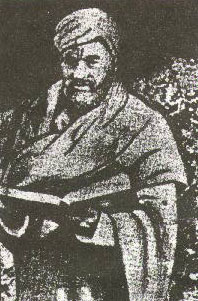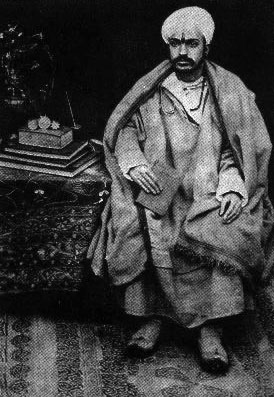Mahamahopadhyaya
Pandit Mukund Ram Shastri
A collosus
among scholars

Pandit Mukund Ram Shastri
| [
From
archaeology and paleography to Kashmir
history to Kashmir Shaivism to grammar and
literature Mahamahopadhyaya Pandit Mukund
Ram Shastri (MRS) strode like a colossus
in almost every field of Kashmir studies
at the turn of the 19th century and in the
early years of the twentieth. Gifted with
unusual brilliance, MRS worked with
Western scholars of the times like Aurel
Stein, Sten Konow, Spooner, Prof. Hiltzch,
Pope Ved, John Marshal and George Grierson,
helping them with his outstanding
erudition and intellectual abilities and
winning fulsome acclaim from them. His
name inspired tremendous respect in
academic circles in India and Europe,
making John Marshall to say: " There
is no Pandit in India of whom I have heard
such consistent and such high praise from
all with whom he came into contact. "
] |
Mahamahopadhyaya
Pandit Mukund Ram Shastri was an extraordinarily
gifted Pandit of Kashmir whose extensive knowledge
and vast erudition won him a dazzling place in
Pan-Indian, and even in European, scholastic
circles. In fact, his name became a legend during
his lifetime, evoking feelings of respect and
admiration in scholars of even the highest order.
Born to Kashmiri Pandit
parents, Pandit Ganesh Bhatt Ganjoo and Amravati,
in the Sathu Barbarshah locality of Srinagar,
Pandit Mukund Ram had his early education at the
local Sanskrit Pathshala under the tutelage of
Pandit Daya Ram Kaul. He acquired the degree of
Shastri, then a covetted degree for those who went
in for Sanskrit studies, from Punjab University,
Lahore. Shastri became an inseparable part of his
name thereafter.
Soon the young Shastri
found himself translating Persian and Arabic books
into Sanskrit under the supervision of Pandit
Ramjoo Dhar, which brought him into limelight in
the world of Sanskrit academics. This prompted
Ranbir Singh, the Maharaja of Jammu and Kashmir
state, to offer him the prestigious assignment of
translating a Tibetan Buddhist treatise "Kangur
and Tangur" into Sanskrit. Learning Tibetan
from Thomas Tamsel, MRS completed the stupendous
task of translating the 1,50,000 verses with great
competence and ability. This enhanced further his
reputation as a scholar and earned him a cash
award of Rs.500 - quite a huge sum those days.
Impressed, the Maharaja
asked MRS to accompany Lama Gure to Paddar in
Kashtwar, Kashmir, where the latter had to conduct
research on sapphires in which the area is rich.
It was here that he came into contact with the
well-known European orientalist Pope Ved, who was
engaged at that time in preparing a book on
Kashmiri grammar. MRS assisted Ved with great
ability, displaying a deep study of Kashmiri
syntax and grammatical forms. Soon afterwards MRS
was appointed as Sanskrit teacher at CMS Biscoe
School, Srinagar, a school run by Christian
missionaries, but gave up the job on the request
of Aurel Stein who arrived in Kashmir in the year
1899 for translating the Rajataringini. MRS
assisted Stein in several ways till his great work
was completed. It was on Stein's recommendation
that MRS helped Grierson while he was engaged
working on his linguistic survey of India. Thus
began his two decade association with Grierson
which saw publication of works like the dictionary
of the Kashmiri language and an annotated
translation of Krishna joo Razdan's "Shiva
Parinaya."
On the request of A.W.
Straton, who was Registrar Punjab University,
Lahore from the years 1900 to 1902, MRS wrote
"Katak Bhasha Sutra", a work of great
value.
As was natural, when the
Research Department was set up by the Maharaja's
government in 1912, MRS was chosen as its Head
Pandit. Later, he rose to the position of Officer
Incharge, Research and Archaeological Department,
a post he held till 1919.
In 1908, MRS worked
closely with Sten Konow, Epigraphist to Government
of India, and David B. Spooner, Superinten- dant
Archaeological Survey. MRS was a great help to A.M
Francki during the latter's archaeological
explorations in Ladakh-Tibet border, in
deciphering Sharada and Devanagari inscriptions.
Wrote Francki, who was senior Archaeologist,
Government of India "The Dras inscriptions
which had been given up in despair by Sir William
Cunningham became perfectly intelligible under the
treatment of Mukund Ram Shastri. This gentleman
has extra- ordinary ability to decipher and
interpret inscriptions in Sharada and Devanagari
which are in bad state of preservation."
During the years 1903 to
1907, MRS worked on ancient history of Kashmir and
ably assisted Spooner in his work on Jonaraja's
"Jaina Rajataringini", which covers
Sultan Zain-ul-Abidin's period. He also proved of
immense help to Sir John Marshall in his
archaeological explorations in Kashmir. But
perhaps the finest hour in MRS' life was when he
critically edited a whole series of texts on
Kashmir Shaivism during his tenure in the Research
Department of Jammu and Kashmir. Of the 29 books
brought out by the Department under the title
"Kashmir Series of Texts and Studies",
as many as 23 were edited by MRS, including
"Shiva Sutra Vimarshini", "Spanda
Karika", "Tantraloka", "Tantrasara",
"Ishwar Pratibijnya", "Paratrimshika"
and "Parmarthasara". This series of
Shaiva texts is perhaps a monumental
accomplishment of the great scholar for which his
name shall be ever taken with pride and. profound
respect.
MRS also edited and
published "Mahanaya Prakash" one of the
earliest extant works in Kashmiri.
Apart from these texts,
the compilation and translation of Lalla Dyad's
verses under the title " Lalavakyani" by
George Grierson and L.D. Barnelt in 1920 also owes
much to the labours of MRS, who also helped
Grierson in editing the "Kashmira Shadamrita"
by Ishwar Kaul.
With such brilliant
attainments to his credit it is no wonder that the
title "Mahamahopadhyaya" was conferred
upon MRS in recognition of his profound knowledge
of a vast range of subjects from Sanskrit language
and literature and philosophy to grammar and
epigraphy.
MRS left his mortal frame
in 1921, leaving behind the imprint of his genius
on his great works of scholarship.
To his Western
counterparts he was a kindred spirit. Grierson
called him his "old friend". Stein
observed: "I shall always be glad to remember
him among my friends". Dr. Hutzch records
"In him also I hope to have found at once a
friend whom I shall never forget". To all
those for whom Kashmir is not just a geographical
denomination but a repository of learning and
ideas, MRS will ever, remain a guiding star.
Source:
Unmesh
- Monthly Newsletter of N.S.
Kashmir Research Institute
|















No one has commented yet. Be the first!